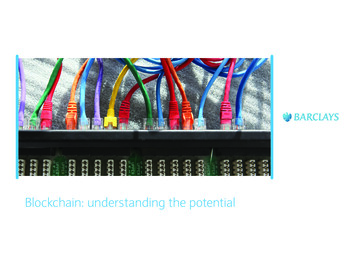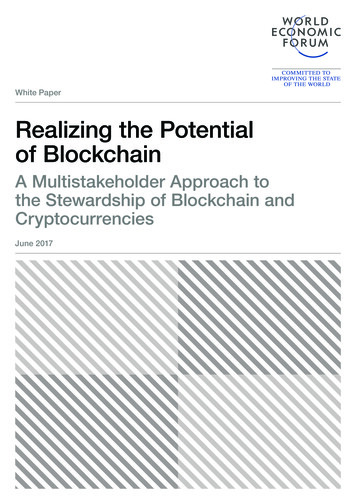
Transcription
Making Blockchaina Reality
ContentsSummaryUntil recently, the world of finance was seen as a highly technical, highly regulated industry dominated bygiant banks that resisted disruption (other than the occasional global meltdown). However, the finance industryis now riding an entrepreneurial wave, with blockchain at the helm.Summary 03No Responsibility, No Progress 04The Remittance Revolution 05Fear of the Unknown? 06Collaboration at the Core 07Access the Infrastructure, Access the Opportunity 08Getting Ready 10Demand for start-up services is now stronger than ever, piqued bywidespread frustration with historically cumbersome big banks thatwere unable to move at the speed or direction that was needed tomeet market need. However, as financial institutions realise thattheir only way to ride this wave is to embrace (and often partner)with these new start-ups, we are set to see a perfect marriagenever before witnessed.So, why have financial institutions been so slow to embracetechnology, and in particular, blockchain? 02 03
No Responsibility,No ProgressBlockchain could represent the next bigshift in technology over the next fiveyears but the pace of innovation withinfinancial institutions seems to be slow.Lack of accountability is the main reason that hinders organizationsin embracing innovation, and blockchain is not different from thisperspective, as affirmed by 46% of respondents in a recent surveyby Deloitte1.What is the biggest concern that is preventingyou from starting this journey?The RemittanceRevolutionPatrick Laurent, Partner at Deloitte comments that “these resultsare not surprising, but give a clear indication of the immediateneed to begin learning courses, workshops and develop Proof ofConcepts (PoCs) in order to develop a good understanding of thetechnology and to mobilise staff with the capabilities to act on it.”From what Deloitte observe in the market, 2016 is the year whichsees the move from the across EMEA to gain a clear understandingof their current plans and status with blockchain technology hypephase to prototype phase. They are predicting the developmentand launch of the first blockchain PoCs within the financialservices industry at a company level and banks must respond tothis. However, in this scenario, the majority of financial institutionsinterviewed seem unprepared to tackle the upcoming challenge.26%46%Regulatory/ legaluncertaintyNo ty3%SustainabilitySecurityOne factor that is driving this market disruption is the movement ofmoney from a period of high dollar amount and low transactionvolumes to low dollar amounts and high transaction volume.This is best exemplified by the explosive growth in internationalremittance and SME cross border payments, both equating toover 6 Trillion a year. Earlier this year Deloitte commissioned asurvey to financial institutions across the globe to understand howFinancial Services are reacting to the blockchain revolution anda staggering 60% indicated that this was the area where they arelooking to focus on (fig.1).International money transfers are thought to represent a 6Trillion annual opportunity and this may be the reason why somany interviewed saw their case for blockchain here, but why?Currently most consumers and SMEs choose to use moneytransfer intermediaries rather than their own banks becauseWhile we accept we are in theearly stages of learning andadopting blockchain technology,we question why the vastmajority of respondents whounderstand the profound impactthe technology can have, are yetto appoint people within theirorganisation to get to grips with it.Blockchain technologies, like the Ripple Protocol , enable thecreation of the lower cost system that banks need to compete.Because these systems use a distributed ledger approach,banks can utilise real-time settlement (RTS). This lowers theadministrative and opportunity costs associated with the currentcorrespondent banking system and as a result, customers canbe retained. But how ready are banks to make this opportunitya reality and will SWIFTs Global Payments Innovation Initiative(GPII)2 , designed to improve the cross-border paymentsexperience, take the wind out of those sails?International money transfers60%Securities clearing and settlement23%KYC and anti-money laundering20%Fiat currency payment and settlement19%Creating transparency19%Decentralised notaryFig.1.What will yourinitial blockchainuse case be?Patrick Laurent, Partner at DeloitteBlockchain could represent the next big shift in technology over thenext five years but the pace of innovation within financial institutionsseems to be slow; for example very few banks have a blockchainlab. A radical change in culture is required to re-think banks’business models in order to prosper in the future. So banks mustdevote adequate focus and manpower if they are to keep up pacewith the market, but, once established, focus must be on the truebenefit rather than just exploratory. So which areas do banks seethe most opportunity? 0416%Fraud deterrent15%Asset registries12%Security issuance and transfer11%Prediction and stock markets7%Syndicated lending7%Securities asset servicing7%Trade surveillance5%Collateral management5%Derivatives contracts and clearing5%Other1) Deloitte EFMA KBC Blockchain Survey, April 2016 - an in depth survey to 3000 C-level managers within the finance industryacross EMEA to gain a clear understanding of their current plans and status with blockchain technologythe costs structures are too high. If banks wants to retain theircustomers and earn extra revenues, they must adopt a lowercost system. And it is clear that banks are starting realise thatblockchain may be the answer.9%2) SWIFT have announced that 73 banks worldwide have now joined its Global Payments Innovation Initiative (GPII), designed toimprove the cross-border payments experience. Recent banks to join the initiative include, Alfa-Bank, Axis Bank, Banco de Créditodel Peru, Banco do Brasil, Bangkok Bank, Bank of Nova Scotia, Banque Européenne d’investissement, CaixaBank, CanadianImperial Bank of Commerce, Credit Agricole, CTBC Bank, E.Sun Commercial Bank, Fifth Third Bank, ICICI Bank, Itaù Unibanco,Mashreq Bank, Promsvyazbank, Rabobank, Svenska Handelsbanken, Swedbank, TMB Bank and U.S. Bank 05
This year will see thedevelopment andlaunch of the firstblockchain proof ofconcepts in FSI at acompany level.Patrick Laurent, Partner at DeloitteFear of theUnknown?Collaborationat the CoreIt was recently claimed that 2016 Wall Street blockchaininvestment alone is set to top 1Billion3, but how prepared arebanks in general? Deloitte survey found that despite a risingawareness about the potential of blockchain, the majority offinancial institutions are still at the beginning of their journey withthis technology.Technology achieves nothing new without trusted parties(including specialist partners) and networks where all participantcan do business together. A good example can be found withinSouth East Asia where some small banks, which haveoperations in multiple entities, are already undertakingcross border (RTS) through the blockchain using Rippleinfrastructure.Where are you in the blockchain journey?The rationale is that the cost of running RTS was so much lowerthan using SWIFT with its associated costs. Because theyare actively using blockchain already, they are ahead ofunderstanding alternative ledgers, so when the inflection pointdoes hit, they are ready.43%28%LearningWe have notyet started21%3%Investment instart-ups3%Collaboration in group/market initiativesBy adopting this approach they can have real calculationson how the system benefits them rather than waiting for theultimate R34 report to come out, then they can be ahead of thegame by being able to develop products accordingly.So cheap, efficient international RTS using blockchain works forsmall, banks with multiple entities but what about the majority?Build solutionDespite the recent news that a number of leading financialinstitutions are exploring the technology through workinggroups, including R3, none of the respondent firms fromthe survey had developed their own centre of excellence, eventhough some leading players had set up incubators and starteddeveloping internal capabilities. Rather, the 71% majority areeither learning about blockchain (43%) or have not yet startedtheir journey (28%) and 50% have not yet appointed ablockchain business owner. Deloitte predict that 2016 is the yearwhich sees the move from the hype phase to prototype phase.They believe that this year will see the development and launch ofthe first blockchain proof of concepts in FSI at a company level.In this scenario, the majority of financial institutions interviewedseem unprepared to tackle the upcoming challenge. So howcan banks quickly catch up to avoid missing thisopportunity?3) 2016 Wall Street blockchain investment to top 1bn http://bit.ly/28RvOk2 06Small banks, which haveoperations in multiple entities,are already undertaking crossborder (RTS) through theblockchain.Pavel Bains, CEO, Bluzelle4) R3 (R3CEV LLC) is a blockchain technology company that leads a consortium of45 financial companies in research and development of blockchain usage in thefinancial system. 07
Access the Infrastructure,Access the OpportunityHistorically, banks have relied on vendor‑specialized experts todevelop complex coded interfaces between all of their systems.Unfortunately, this approach means that banks struggle tointegrate new business systems (including partners that enablebanks to utilize blockchain functionality), fast and cost‑effectively.In addition, this point-to-point integration approach that bankstend to adopt is more difficult to support real‑time business acrossmultiple channels, which makes supporting real-time settlement(RTS) impossible.This level of flexibility, often through the use of an advancedpayment hub, enables banks to integrate systems much faster, torealise this 6Trillion opportunity in a competitive world.Back in May this year5, Bluzelle Networks6, a payments platformleveraging the Ripple Infrastructure, became available throughthe Temenos MarketPlace7, and demonstrated the ease whichRTS systems can integrate and run on established, yet agile, corebanking systems8. With this particular model, Pavel Bains, CEOof Bluzelle recounts that “a bank teller performed a transaction inreal-time by simply keying in the appropriate information to sendCanadian Dollars (CAD) to another bank where the recipientwas expecting EUR.” Adding that “the transaction, foreignexchange and settlement all happened in seconds over theblockchain and all ledgers were updated concurrently.”This particular process has the potential to be seamless whenintegrated with the right infrastructure and the more banksuses the same core banking system (through an agile providerchampioning this approach), the bigger the network grows.The end result is an international payment network of thousandsof trusted banks, doing things the same way, and seamlesslysending funds to one another. Used in the right way and throughthe appropriate model to ensure minimum revenue loss from abank perspective, this approach could lead to new revenuestreams and products that give more value to your customers.Benefiting from RTS using blockchain caneasily become a reality for banks of any size,but their core architecture and integrationframework must be sufficiently agile.Darryl Proctor, Product Director – Transaction Banking and Payments5) At Temenos Community Forum (TCF) 2016, Barcelona6) Bluzelle is an established Temenos partner available through the TemenosMarketPlace (marketplace.temenos.com).7) Temenos Marketplace is a free web-based application. It allows you to use andmanage business applications in one simple and secure site, from anywhere.8) Bluzelle was run on Temenos Core Banking Platform for the demonstration.Banks currently using Temenos Core Banking can send payments to each other inreal-time. This is done via Bluzelle Altitude which allows for payments to go over theblockchain in the secure and authentic way banks are used to. 08 09
GettingReadyThe global financial services market is proving it is ready forthis technology in a number of ways. Investment in blockchainhas now exceeded 1Billion and more than 30 pilot projectsare completed. However, a high proportion of the researchundertaken to date has looked into the capability of blockchainto modernise costly and inefficient legacy systems/old processes.Several leading banks including Intesa Sanpaolo and Unicredit,and the leading e-commerce payments institution in Italy, BancaSella, have published several white papers and articles aboutblockchain and are actively recruiting blockchain developers andpromoting initiatives in this space.As well as championing a blockchainlab, Temenos are working with partnersand banks to create proof of conceptsto address this gap. However, thetechnology can solve the technicalissues, but a coherent strategy isrequired to solve the market adoptionand truly realise this perfect marriage.AuthorEmma WadeyProduct StrategyTemenos France SASSponsoring or organising blockchain hackathons is just one waythey are promoting the technology9. Other groups include R3 andCaisse des Dépôts10. Eventhough these initiatives are importantfor the industry, these consortia operate in a ‘lab’ environment,not taking into account the full ecosystem required for theoperationalization of a viable use case.Whilst there is no doubt that research and transferring knowledgeis essential, we must not forget that there are opportunities tobenefit now. 60% of banks interviewed by Deloitte said thatInternational money transfers were their main focus from ablockchain perspective, and we have heard that benefiting fromthis market through infrastructures using Ripple by working withagile partners really can be a reality.So banks can benefit now from an international money transferperspective, however, to progress it must not stop there. To seethis technology embraced we need to complete the network withparties at both ends integrated to the common platform.About TemenosTemenos AG (SIX: TEMN), headquartered in Geneva, is the world’s leader in bankingsoftware, partnering with banks and other financial institutions to transform their businessesand stay ahead of a changing marketplace. Over 3,000 firms across the globe, including41 of the top 50 banks, rely on Temenos to process both the daily transactions and clientinteractions of more than 500 million banking customers. Temenos offers cloud-native,cloud-agnostic front office and core banking, payments, fund management and wealthmanagement software products enabling banks to deliver consistent, frictionless customerjourneys and gain operational excellence. Temenos customers are proven to be moreprofitable than their peers: over a seven-year period, they enjoyed on average a 31%higher return on assets, a 36% higher return on equity and an 8.6 percentage point lowercost/income ratio than banks running legacy applications. 2016 Temenos Headquarters SA - all rights reserved.Warning: This document is protected by copyright law and international treaties.Unauthorised reproduction of this document, or any portion of it, may result in severe andcriminal penalties, and will be prosecuted to the maximum extent possible under law.9) Prime examples to note are Fidelity and Citi in Dublin, and BNP Paribas in Paris,Brussels, Rome, Istanbul and San Francisco10) Caisse des Dépôts was launched in France to bringing together 11 partnersfrom insurance, banking and FS industry groups, working to leverage their researchin exploring blockchains potential and investigating the ethical, regulatory andnormative aspects of the technology.Learn MoreTo find out how Temenos can help with your digital banking needs, contactsales@temenos.com or visit us at www.temenos.com 10 11
Aug 21, 2019 · Revolution Blockchain could represent the next big shift in technology over the next five years but the pace of innovation within financial institutions seems to be slow. Lack of accountability is the main reason that hinders organizations in embracing innovation, a










